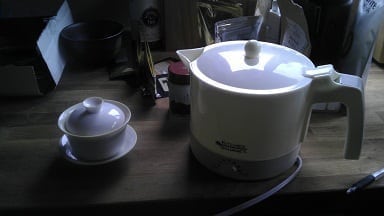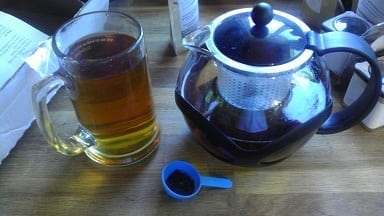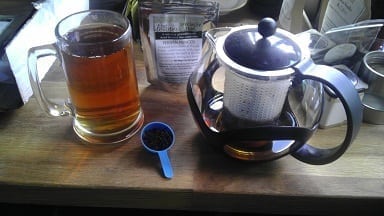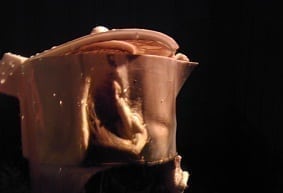I might sound like a broken record here, but the last couple of weeks or so have been insane. Moments of import at casa de chaos are innumerable and frustrating…and totally not worth reflecting upon. Instead, I want to pay homage to the good things – the tea trifecta, if you will – that have happened in recent weeks. Starting with…

Golden Fleece Feast Fest
Nearly a month ago, I lamented via the social mediasphere – like I always do – about everyone’s acquisition of Verdant Tea’s Golden Fleece. I remember everyone extolling its virtues from on high. Envy set in like a car crash. I love Yunnan blacks; I love Yunnan golds more. Unfortunately, it was never in my budget to acquire some – either back then or now.
Ever the tealanthropist, Rachel Carter of IHeartTeas offered to send me a sample of this year’s batch. A couple of others were also including in the gifting. Not sure if I was the first to suggest it, or if someone else whispered in my ear, but the idea to do a “tandem blog” gained favor. I.e. Everyone trying the tea at the same time – discussing it over a chat medium first – then simultaneously posting blogs about their experiences.
Naturally, I agreed to it (or patted myself on the back for the idea, whichever), forgetting one simple thing. I suck at keeping to a deadline, unless I’m being paid for it. Tandem blogging was probably the most antithetical idea I could’ve agreed to or suggested. It didn’t help that I was in the midst of some home-related SNAFUs at the time.
Google+’s Hangout feature was our chosen get-together medium. Participants included: The aforementioned Fleece-gifter, Rachel, Nicole Martin of Tea For Me Please, Jo Johnson of A Gift of Tea, Jackie D (aka. Mrs. Tea Trade), and Darlene Meyers-Perry of The Tea Lover’s Archive. I was the only guy there…and it showed. A joke by me involving the “b-word” in reference to my cat was met with shocked gasps. Sometimes, I should adjust my social filter to “Female”.
That said, it was an extremely animated evening gathering. I was duly caffeinated by the end of it, and equally energized by all the tea talk. As you can tell by the glibness of this post so far, I don’t get to do that very often. Tea gatherings, for me, are like a nerd-geyser going off.
Oh yeah! The tea itself…

The leaves looked like a Yunnan Jin Cha (or “Gold Bud”) through and through. What was different about these buds, though, were the furs. Yes, these leaf buds still had downy furs present – like a good Yinzhen does. I’ve had many a Yunnan gold, but this was the gold..-iest. (I know, not a word.) Taste-wise, it was smooth, silky, honey-like, and a tad malty on the finish. It lacked some of the peppery lean others of its ilk possess, but that was hardly missed. It was, in a word, perfect. As was the gathering.
Thanks again, Rachel, for the sample and conversation. I’ll do better on the tandeming next time. Er, maybe.
To read Nicole’s take, go HERE.
To read Jo’s take, go HERE.
To read Rachel’s take, go HERE.
To purchase Verdant Tea’s Golden Fleece, go HERE.
A Taste of Eugene
Remember a year or so ago how I wrote about trying a gin barrel-aged oolong beer? You don’t? Well, go HERE, then get back to me. Done? Good. Well, what if I told you that beer had a f**king sequel?!
I found out (again) from Josh Chamberlain of J-TEA that Oakshire Brewing came out with yet another rendition of the Frederic’s Lost Arm. This new one was from the same batch, but instead of a gin barrel, the Oakshire boys aged it for two years in a Pinot Noir barrel – thus dubbing it Frederic C. Noir. Unfortunately, none of the rare bottles were going to make it to Portland.
After a week of himming-and-hawing, I asked the kind folks at 16 Tons if they still had any left available. They said, “Yes.” A split second later I said, “Hold one for me, I’m coming down.” Keep in mind, this shop was in Eugene…which is a two-hour drive from Portland. I decided to devote one of my day’s off to the road trip.
I haven’t tried the beer yet, so that’ll be a subject for another post. What I will share here is my major (and enlightening pit stop) before picking it up. I decided to pre-funk at the very tea shop that provided the oolong for said beer in the first place. I had heard great things about J-TEA, and I’d associated with the owner via Twitter on a few occasions. My first aged oolong ever was acquired there – an aged Dong Fei Mei Ren (Oriental Beauty/Bai Hao) oolong. Loved that stuff.
Never heard of the place? Well, it’s the shop in Oregon for the aged oolong crowd. Josh’s selection is probably the most extensive I’ve come across. My main reason for going – other than picking at Josh’s brain – was to sample some 20-year-aged Baozhongs.

Josh was kind of to preside over a taste comparison between a 1984 and 1989 Baozhong offering. Both were exquisitely herbaceous and strangely calming. I’m sure that “calm wakefulness” crap that tea folks talk about stems from trying aged oolongs. I didn’t feel too wired, just…aware. Of the two, the ’84 was a clear favorite; there was something deeper at play in that cup. Not sure how to properly explain it, something just clicked with me.
The second treat he dished out was one I had inquired about several months prior. For a Black Friday event, Josh had processed some leaves he picked from Minto Island Growers into a black tea. For those not familiar with MIG, they’re an outfit with a section of garden devoted to tea varietals in Oregon. Yes, you heard right. Tea plants in Oregon! And lucky for me, there was still some of J-TEA’s black experiment left.

What can I say, it was darn near perfect, and note-for-note like a Taiwanese Ruby 18. The cuppa was chewy and chocolaty with an odd floral sensation in the top note. I instantly wanted more. Since there wasn’t a lot to go around, J let me keep the leaves to re-steep. Which I did. Four times. Those suckers were resilient.
I made a purchase of some ’09 Li Shan black, and settled my bill for the tea tasters o’ awesomeness. Before I left for the beer leg of my journey, we went on a dialogue tangent about barrel-aged teas. Right as I was about to leave, Josh mentioned in passing, “I acquired a bourbon barrel from Kentucky.”
Damn it. The man knows my weakness.
To check out J-TEA’s selection of aged oolongs, go HERE.
For their selection of black teas, go HERE.
It’s a Beautiful Day in the Neighborhood
The first weekend of every month starts with an event in our neighborhood simply known as “Beer Night”. I know, clever. Each month has a theme. Some notable ones from the past months were “Weird Beers”, “Foreign Beers”, “Wheat Beers”, and so on. This month, it was “Beer Cocktails”…and I had no idea what I was going to contribute. Initially, I was going to offer up my tea-beer experiment, but the weather was too hot to justify it. As a result, I decided to skip out on it.
Both my neighbor Tim and my brother talked me out of it, and – truthfully – it didn’t take a lot of arm-twisting. It’s beer. Good beer. And good people. I would eventually give in.
Neighbor Tim and his wife, Katie, had just returned from Ethiopia to meet twins they were adopting. Before they left, I texted Tim as an afterthought, “If you can, pick up some Ethiopian-grown tea!” I knew the stuff existed after a conversation with Cinnabar Gong Fu of Phoenix Tea from a couple of years back. While not officially on the “Tea WANT!” list, it was a contender.
Well, when I got to the barbeque with my brother, Tim’s wife came up to me and said they had picked up nearly a kilo of Ethiopian tea. I was shocked by the amount she signified…until she told me how cheap it was. At the end of the gathering, Tim gifted me with 100 grams of it.

And I tried it the next morning.
It’s not a complex tea by any stretch. If anything, because of the thin (practically fannings) cut of the leaves, the liquor had a lot in common with cheap Rize-grown Turkish black tea or like products from Guatemala or Bolivia. However, it wasn’t as astringent as the South American stuff, or as sweet as the Turkish, but very reminiscent of Australian Daintree.
The best part? It iced well. My god, did it ice well.

What? I’m an American. We do that here.
In closing, I suppose I can sum up that the best and simplest things in life fall back to good tea and good people. Well, for those of us that like tea. And people. Jury’s still out on the “people” part, but so far, I’ve had pretty good luck.



















































